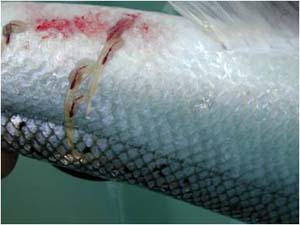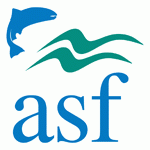More than 200 researchers from the around the world met in Portland last week to discuss a topic of crucial significance to the global aquaculture industry: sea lice

They infest the open-net salmon farms and then hop on wild salmon swimming past. Some studies report that 95% of juvenile salmon that rear near fish farms are killed by the lice.
[dropcap]T[/dropcap]he parasite is a type of pesky copepod that grazes on the skin of fish and is especially troublesome for fish farmers, since the lice thrive in areas where a large number of fish are concentrated in pens. Sea lice are estimated to cost the global aquaculture industry about $300 million a year, according to Ian Bricknell, a professor of aquaculture biology at the University of Maine in Orono and one of the conference organizers.
The selection of Maine as a spot for the five-day conference reflects the global importance of the state’s salmon-farming industry and the aquaculture research efforts going on at the University of Maine, according to Bricknell.
“We have 200 of the world’s leading scientists in the field here,” said Bricknell, noting attendees came from as far away as Norway, Sweden, Mexico and Australia.
Maine’s salmon farms, which are all located Down East and owned by New Brunswick-based Cooke Aquaculture, harvested 32,000 tons of farm-raised salmon in 2013, according to Bricknell. While Norwegian salmon farms dwarfed that amount with their harvest of 170,000 tons, Maine produces about 80 percent of the United States’ total volume of farm-raised salmon, Bricknell said.
The salmon farming industry has been criticized in the past for practices that pollute the environment and for its use of antibiotics and chemicals to combat disease and sea lice infestation. But the industry is changing, said Bricknell. More sustainable farming methods and methods to manage sea lice are being developed and Maine researchers are at the forefront of that effort.
For instance, Bricknell, a self-described “fish nerd,” and his research team have discovered that farming blue mussels alongside salmon pens helps to alleviate the sea lice problem because the mussels feed on sea lice larvae. Trials were held at Cooke Aquaculture’s pens Down East.

The industry of Aquaculture is very profitable, very polluting and has many health risks associated with it, as well as, tampering with wild stocks survival.
“We certainly found both in the laboratory and in the field that they’re very efficient at predating these sea lice larvae,” Bricknell said. “It’s still at the research stage, but this is very encouraging.”
The attendees are spending their week presenting research papers and discussing issues such as the recent successful mapping of the sea louse’s genome and the impact of plankton nets to prevent sea lice, all topics that will play into how fish farms can manage the sea lice problem.
Bricknell said companies in Canada and Norway are using UMaine research to design fish farms to raise finfish like salmon alongside mussels. He said other researchers have replicated the experiments and have found similar results farming oysters and scallops alongside fish farms.
The implications for this type of integrated pest management in the aquaculture industry are large.
“Not only do farms get free lice control, but they get a second crop that has a market value,” Bricknell said.
Maine’s role in the global aquaculture industry is expected to increase thanks to a $20 million grant from the National Science Foundation to establish the Sustainable Ecological Aquaculture Network, or SEANET, at UMaine. The grant’s goal is to turn Maine’s 3,500-mile coast into a “living laboratory” to study social and environmental interactions among sustainable ecological aquaculture and coastal communities and ecosystems.
“This research project will use various types of science to understand how aquaculture fits in our multi-use working waterfront, while building partnerships and training students, so that we can use similar approaches to other coastal resource management issues in the future,” Paul Anderson, director of SEANET, said in a statement at the time.
Bricknell added: “Aquaculture is going to be a very exciting area in Maine for the next decade and way beyond that.”




